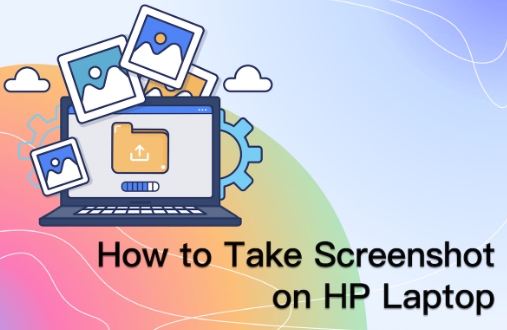How to Screenshot on HP Laptop is an essential skill that can be useful for various purposes, such as saving important information, sharing visual content, and troubleshooting technical issues. This guide provides step-by-step instructions on different methods to take screenshots on your HP laptop, using both built-in tools and third-party software. Whether you’re a beginner or an advanced user, you’ll find the right method to suit your needs. By the end of this guide, you’ll be able to efficiently capture and save screenshots, ensuring you never miss any crucial information displayed on your screen.

How to Screenshot on HP Laptops Using Keyboard Shortcuts
Print Screen Method
The simplest way to capture your entire screen on an HP laptop is by using the Print Screen (PrtScn) key. Pressing the PrtScn key copies the entire screen to your clipboard. You can then insert the screenshot into an image editor or document by using Ctrl + V. This method is quick and straightforward, ideal for capturing the whole screen with minimal effort.
Alt + Print Screen Method
For capturing a specific window, use the Alt + PrtScn shortcut. This method allows you to capture only the active window, excluding the rest of the desktop. Press Alt + PrtScn, and the screenshot of the active window will be copied to your clipboard. You can then paste it into an image editor or document. This method is particularly useful when you need to focus on a single window without capturing the entire screen.

Windows + Print Screen Method
To automatically save a screenshot as a file, use the Windows + PrtScn shortcut. This method captures the entire screen and saves the screenshot directly to the Screenshots folder in your Pictures library. Press Windows + PrtScn, and the screen will briefly dim, indicating that the screenshot has been taken and saved. This method is convenient for those who prefer having their screenshots automatically saved as files.
How to Screenshot on HP Laptops Using Snipping Tool
Opening the Snipping Tool
The Snipping Tool is a built-in Windows application that offers more flexibility than keyboard shortcuts. To open the Snipping Tool, search for it in the Start menu and click on the application. Once open, you can choose from various snipping modes to capture different parts of your screen. This tool provides a more controlled way of taking screenshots, especially for users who need specific portions of the screen.
Using Different Snipping Modes
The Snipping Tool offers four snipping modes: Free-form, Rectangular, Window, and Full-screen. Select the mode that best suits your needs. Free-form allows you to draw a custom shape, Rectangular captures a selected rectangular area, Window captures a particular window, and Full-screen captures the whole screen. After selecting a mode, click New to capture the screenshot. You can then save or annotate the screenshot as needed.
How to Screenshot on HP Laptops Using Snip & Sketch
Launching Snip & Sketch
Snip & Sketch is a more advanced tool introduced in Windows 10. To launch Snip & Sketch, press Windows + Shift + S or search for it in the Start menu. The screen will dim, and a small menu will appear at the top, offering various snip options. This tool provides enhanced functionality and better integration with modern Windows features.
Capturing Screenshots with Snip & Sketch
With Snip & Sketch, you can choose between Rectangular, Free-form, Window, and Full-screen snips. After selecting your preferred snip type, capture the desired area. The screenshot will appear in the Snip & Sketch editor, where you can annotate, crop, and save it. This tool is perfect for users who need to edit their screenshots before saving or sharing them.
How to Screenshot on HP Laptops Using Third-Party Software
If you require additional features, consider using third-party screenshot software. Programs like Greenshot, Lightshot, and Snagit offer advanced options such as scrolling captures, delayed snips, and integration with cloud storage. These tools can be downloaded and installed easily. Once installed, configure the software to your liking and use it to take screenshots with more flexibility and control than the built-in tools.
Tips and Tricks for Taking Better Screenshots on HP Laptops
To enhance your screenshotting experience, consider these tips: Ensure your screen resolution is set to the highest quality for clear images. Use the zoom feature to capture detailed screenshots. Keep your desktop organized to avoid capturing unnecessary clutter. Practice using different methods to find the one that works best for you. Lastly, learn keyboard shortcuts to save time and increase efficiency.
Conclusion
How to Screenshot on HP Laptop is a versatile skill that can assist with various tasks, from creating tutorials to saving important information. By mastering the different methods outlined in this guide, you can choose the most effective way to capture your screen. Whether you prefer quick keyboard shortcuts or more detailed tools like Snipping Tool and Snip & Sketch, you’ll be able to take screenshots with ease. Experiment with these methods to find the one that suits your needs best, and start capturing your screen efficiently today.
FAQs
1.How do I screenshot a specific window on my HP laptop?
To screenshot a specific window, use the Alt + PrtScn shortcut. This captures only the active window and copies it to your clipboard, which you can then paste into an image editor.
2.Can I take a screenshot on my HP laptop without using the keyboard?
Yes, you can use the Snipping Tool or Snip & Sketch applications to take screenshots without relying solely on keyboard shortcuts. These tools provide various snipping options and can be accessed from the Start menu.
3.What should I do if my HP laptop screenshots are not saving?
If your screenshots are not saving, check your keyboard shortcuts and ensure you are using the correct key combinations. Additionally, verify that your Screenshots folder in the Pictures library has the necessary permissions and enough storage space. If problems persist, consider using third-party screenshot software for more reliable performance.
